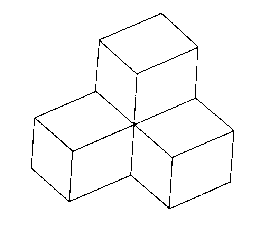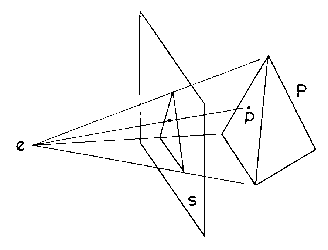
Figure: Polyhedron that is rectangular but not trihedral.
Hermann Weyl, 1951 [66].
Now let's take a look at Sugihara's famous assumptions on line drawing interpretation problems:
1. Assumptions on Objects:
Assumption O1: Polyhedrons are bounded and homogeneously three-dimentional.
With this assumption we avoid unusual polyhedrons. For instance, Since the polyhedrons are bounded, infinite objects such as a half space are excluded. Since they are homogeneously three-dimensional, lower-dimensional objects such as a sheet of paper are also excluded.Assumption O2: Polyhedrons are topologically equivalent to a ball Assumption O3: Polyhedrons are convex. Assumption O4: Polyhedrons are trihedral.
Assumption O5: Polyhedrons are rectangular.
Note that O5 does not imply O4. The following figure is an example that is rectangular but not trihedral, six faces meet at the central vertex.A vertex is called rectangular if all the faces meeting at the vertex are mutually perpendicular.
A polyhedron is called rectangular if all the vertices are rectangular.

2. Assumptions on Points of View:
Assumption W1: No face of a polyhedron is coplanar with the view point. It implies that every face of a polyhedron corresponds to some region of the picture with nonzero area.
Assumption W2: No pair of edges of a polyhedron is coplanar with the view point unless the two edges are collinear in the space.
It implies that neither distance edges accidentally overlap in the picture nor noncollinear edges become collinear in the picture.Assumption W3: No pair of a vertex and an edge of a polyhedron is coplanar with the view point unless the vertex is one of the two terminal points of the edge.
It implies that a vertex does not lie on an edge in the picture unless the vertex is originally a terminal point of the edge.
Assumption W4: No pair of vertices of a polyhedron is collinear with the view point.
It implies that two distince vertices never fall at the same point on the picture plane.

Note the assumption W2 implies W1, and W3 implies both W2 and W4(hence, W1 too). These types of assumptions are often called nonaccidentalness assumption. So for that Truncated Pyramid Question we mentioned in the introduction part, the situation showed in Figure 1(c) violates assumptions W1, W2, W3, and W4; consequently, if we choose at least one of these four assumptions, we can avoid the tricky answer.
3. Assumptions on Drawing
Rules:
Even if the object surface has texture, scribbles, cracks, or shadows, they are not drawn.
This assumption seems less realistic, but more fundamental for study of the mathematical structure of line drawings.
We have listed many assumptions which are necessary and useful to make the realizability problem senseful. Usually only some subset of these assumption set are adopted. Different subsets define different problems. In this project, the following type of realizability problems are considered:
1. Problem with Assumption(PA)
2. Problem with the View
point(PV)
3. Problem with additional
Knowledge(PK)
4. Problem requiring Flexibility(PF)
In this way we shall distinguish the problem types by thr symbols
PA,
PV, PK, and PF. We shall use the symbols also in combination. For
example, PAV stands for the type of a problem
in which a set of assumptions and the view point are given. PAVK
stands for the type of a problem in which a set of assumptions, the view
point, and additional knowledge about the structure of the object are given,
etc. Obviously a problem of the type PAK is a subproblem of the corresponding
problem of the type PA. Here we are going to talk about a method for decomposing
a type-PA problem into type-PAK subproblems. The method is just the famous
Labeling
Algorithm.